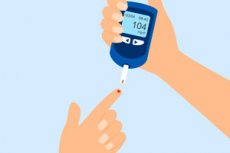A breakthrough in diabetes treatment: understanding the mechanism of glucose regulation
最近審查:14.06.2024

One of the difficult problems for patients with type 2 diabetes is high fasting glucose levels. This is due to the fact that in patients with insulin resistance, the process of glucose production in the liver is triggered, the mechanism of which is still not fully understood by the scientific community. Now, in a review article published in the journal Trends in Endocrinology & Metabolism, presents the most significant advances in understanding this mechanism and identifies new targets for the development of drugs against type 2 diabetes, which the World Health Organization (WHO) calls one of the pandemics of the 21st century.
The study and its participants
The study is led by Professor Manuel Vázquez-Carrera from the Faculty of Pharmacy and Food Sciences of the University of Barcelona, the UB Institute of Biomedicine (IBUB), the Sant Joan de Déu Research Institute (IRSJD) and the Biomedical Research Center for Diabetes and Associated Metabolic Diseases (CIBERDEM). The study participants also included experts Emma Barroso, Javier Jurado-Aguilar and Xavier Palomer (UB-IBUB-IRJSJD-CIBERDEM) and Professor Walter Wachli from the University of Lausanne (Switzerland).
Therapeutic goals in the fight against disease
Type 2 diabetes is an increasingly common chronic disease in which circulating glucose levels are elevated due to the body's insufficient response to insulin. It can cause serious organ damage and is estimated to remain undiagnosed in a significant percentage of the affected population.
In patients, the pathway for glucose synthesis in the liver (gluconeogenesis) is overactivated, which can be controlled with drugs such as metformin. "Recently, new factors involved in the control of hepatic gluconeogenesis have been identified. For example, our study showed that growth and differentiation factor (GDF15) reduces the levels of proteins involved in hepatic gluconeogenesis," says Professor Manuel Vázquez-Carrera.
To advance the fight against this disease, it is also necessary to study pathways such as TGF-β, which is involved in the progression of metabolic dysfunction associated with fatty liver disease (MASLD), which often coexists with type 2 diabetes. “TGF-β plays an important role in the progression of liver fibrosis and is one of the most significant factors contributing to increased hepatic gluconeogenesis and, consequently, type 2 diabetes,” emphasizes Vazquez- Carrera.
Metformin: the mysteries of the most common drug
The mechanisms of action of metformin, the most commonly prescribed drug for the treatment of type 2 diabetes, which reduces hepatic gluconeogenesis, are still not fully understood. The drug was recently found to reduce gluconeogenesis through inhibition of complex IV of the mitochondrial electron transport chain, a mechanism independent of the classical effects through activation of the AMPK protein.
“Inhibition of mitochondrial complex IV activity by metformin—rather than complex I, as previously thought—reduces the availability of substrates required for hepatic glucose synthesis,” notes Vasquez-Carrera.
Next steps
Vazquez-Carrera's team is continuing its research work to decipher the mechanisms by which GDF15 may regulate hepatic gluconeogenesis. "In parallel, we want to develop new molecules that increase circulating levels of GDF15. If we have potent inducers of GDF15, we may be able to improve glycemia in people with type 2 diabetes by reducing hepatic gluconeogenesis and other actions of this cytokine," the researcher concludes.

